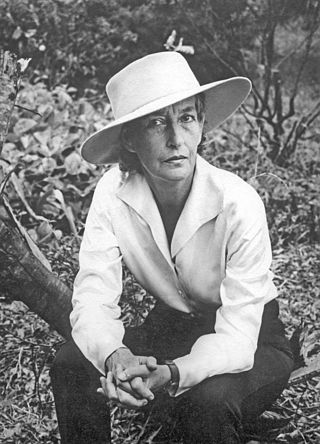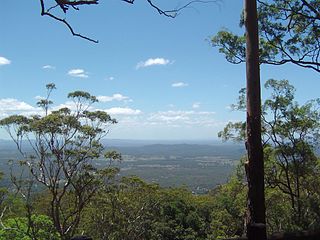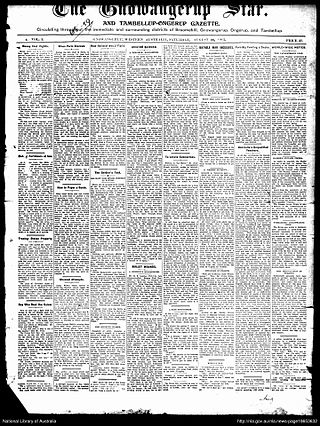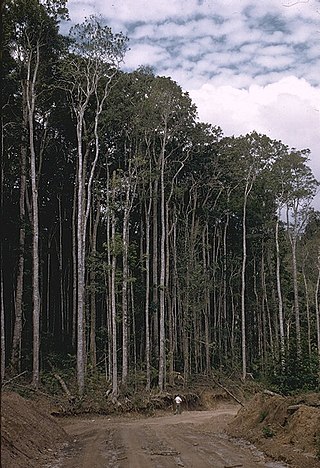
Fleay's barred frog is a large species of frog restricted to small pockets of rainforest in northern New South Wales and south-eastern Queensland, Australia.

Vera Scarth-Johnson was a noted botanist and botanical illustrator who is also remembered for her continual efforts to teach others to treasure the flora and environment of Australia and, in particular, the botanically rich region of Cooktown and the Endeavour River Valley, on Cape York Peninsula, in far northern Queensland.
John McGarvie was a Scottish-born Australian Presbyterian minister and writer.
The Cape Melville tree frog is a species of frog in the subfamily Pelodryadinae. It is endemic to Australia, and has been found only in Queensland, in Cape Melville National Park. Its natural habitats are subtropical or tropical moist lowland forests and rivers.
Mary Julia Wade was an Australian palaeontologist, known for her role as the Deputy Director of the Queensland Museum. Some of her most renowned work was on the Precambrian Ediacaran Biota in South Australia.
M [Michael] Scott Fletcher (1868–1947) was an Australian Methodist minister, foundation master of King's College, University of Queensland, foundation Master of Wesley College, University of Sydney and held the Chair of Philosophy at the University of Queensland.

North Tamborine is a rural town in the locality of Tamborine Mountain in the Scenic Rim Region, Queensland, Australia.
Mount Tamborine is a town within the locality of Tamborine Mountain in South East Queensland, Australia.
Rodney Mark Cavalier is a former Australian politician, statutory officer and author. Cavalier was a member of the New South Wales Legislative Assembly representing Fuller between 1978 and 1981 and then Gladesville between 1981 and 1988 for the Labor Party. During his term in parliament, Cavalier was Minister for Energy, Minister for Finance, and Minister for Education in the Wran and Unsworth governments.

Elizabeth Frances Coxen was an Australian naturalist and meteorologist.
James Percy Owen Cowlishaw (1867–1925) was an architect in Queensland, Australia. He is best known for his Commercial Bank of Australia buildings.
Valerie Todd Davies was an arachnologist who described many species of spider.

The Gnowangerup Star, also published as the Gnowangerup Star and Tambellup Ongerup Gazette, was a weekly English language newspaper published in Gnowangerup, Western Australia.
Valentine Thomas Vallis (1916–2009) was a Queensland poet, lecturer and opera critic.

Jim Gasteen (1922–2017) was an Australian farmer and conservationist, responsible for the establishment of a number of National Parks in Queensland and New South Wales.

James Peter Stanton is an Australian landscape ecologist, fire ecologist, botanist and biogeographer who individually conducted systematic environmental resource surveys throughout Queensland whilst working for the National Parks department of Forestry (Qld.) from 1967–1974. He carried out his assessments in a range of dissimilar landscapes leading to the identification and protection of many critically threatened ecosystems across the state during a period of rapid and widespread land development under the Joh Bjelke-Petersen government. For this work he became the first Australian to receive the IUCN Fred M. Packard Award in 1982.

John Geoffrey Tracey was an Australian ecologist and botanist whose pioneering research work in partnership with Dr. Leonard Webb within the Rainforest Ecology Unit of the CSIRO in the 1950s led to the publication of the first systematic classification of Australian rainforest vegetation in the Journal of Ecology in 1959. By the early 80's, after decades of ongoing research, Tracey and Webb had accumulated a significant corpus of scientific evidence in support of the theory that Australian tropical rainforests had evolved in Gondwana over 100 million years ago and were not, as previously believed, relatively recent arrivals from South East Asia. This evidence, in combination with Tracey and Webb's 1975 publication of a collection of 15 vegetation maps entitled "Vegetation of the Humid Tropical Region of North Queensland", and Tracey's 1982 paper "The Vegetation of the Humid Tropical Region of North Queensland", helped to establish the scientific basis for a number of major conservation campaigns across Queensland and paved the way for the subsequent successful World Heritage nomination of the Wet Tropics of Queensland by Aila Keto in 1988.

Leonard James Webb was a widely awarded Australian ecologist and ethnobotanist who was the author or joint-author of over 112 scientific papers throughout the course of his professional career. His pioneering work as Senior Principal Research Scientist alongside Geoff Tracey in the CSIRO Rainforest Ecology Research Unit in the 1950s led to the publication of the first systematic classification of Australian rainforest vegetation in the Journal of Ecology in 1959.

James Keys was a school teacher and pioneering 19th century Queensland botanist who was globally recognised for the diverse collections of plant specimens which he assembled from locations of floristic significance throughout his home state including Mt Perry, Bundaberg, Bustard Heads, Burrum River, Eurimbula, Pine Mountain, Lake Cootharaba, Blackall Range and Norman Creek. He was a close friend to Queensland Colonial Botanist F.M. Bailey who was Keys' mentor and was responsible for many of Keys collections of lichens and mosses being sent to specialists in Europe for study. With Bailey's encouragement Keys was to compile a comprehensive collection of plants from the Upper Burnett River and Mount Perry which culminated in the first local checklist of plants in Queensland from outside of the Brisbane area. Most of his flora collections which were not sent abroad now reside in the Queensland Herbarium where approximately 600 of Keys' collections are presently preserved. Keys was also recognised for his abiding interest in uses of plants and his documentation of the aboriginal plant names in the Mt Perry district were listed in Bailey's seminal 7-volume botanical book 'The Queensland Flora'.
Samuel Justin Dansie was an Australian forester and botanist who was an influential early figure associated with the emergence of a conservation ethos in the use and management of the Wet Tropical rainforests of Northern Queensland. During his 36-year tenure within the Queensland Forestry Department, Dansie was instrumental in identifying and securing the protection of a number of key conservation areas, both within and outside of state forests in the region.










